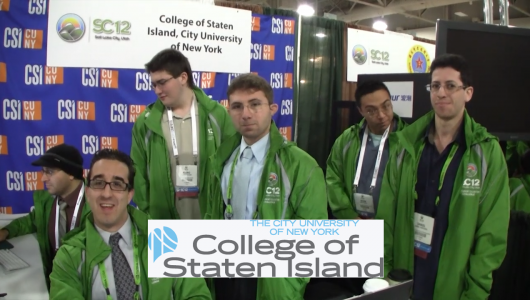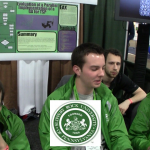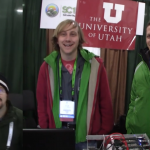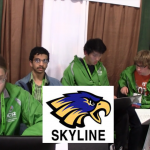Now that the US elections are over, it’s obvious that the world’s attention has shifted to the upcoming Student Cluster Competition (SCC), which will kick off next Monday at SC12 in Salt Lake City.
The traditional ‘Big Iron’ competition (details here) has teams of undergraduates benchmarking their home-grown clusters to see which school is best at wringing the most HPC app performance from only 26 amps (120 volts). This is the event that has become the largest spectacle in computer sports and a beloved part of every SC conference.
But now, there’s something new and different…
It’s the LittleFe track, or as I’m dubbing it, “Mini-Iron”. It’s a pilot competition in which university (or even high school) teams compete with the exact same hardware. In this case, the hardware is a LittleFe v4a system, a six-node cluster in a box. Each node has a single dual-core 1.8GHz Atom ION2 processor and 2GB of memory. The kit also includes a shared hard drive, a gigabit switch, mounting hardware, etc. You can see the whole parts list here.
Teams can use the standard cluster-in-a-box software stack or select their own o/s and application software. The hardware includes an NVIDIA graphics chipset, so using CUDA to take advantage of some GPU processing goodness is fair game.
Let’s meet the teams:
Team Slippery Rock: Slippery Rock University, located in Slippery Rock, Pennsylvania, is sending a team of seasoned upperclassmen who have been around the block when it comes to programming contests and systems in general. One team member has successfully completed the entire set of parallel processing classes offered at the university, and the other team members have had experience with OpenMP and MPI. Most will have had some exposure to CUDA by the time the competition kicks off. Team members have participated on Slippery Rock programming and mathematical modeling teams, so they’ve experienced the pressure of working on a team while competing against others. This will probably come in handy at the Mini-Iron Challenge.
Team Staten Island: Hailing from Staten Island, New York, these students were heavily affected by Hurricane Sandy, and hopefully the cluster competition will provide a welcome and much-needed break. The Islanders are a diverse team of seniors, juniors, and sophomores who are hard to sum up. There’s quite a range here. One guy is focused on AI and robotics, while another is a math major minoring in geology and concentrating in adolescent education; yet another member is a drafting and engineering major. The rest of the team are traditional computer science types, but seem to have extensive real-world technical experience. While other teams talk about the competitions their members have participated in, these Staten Island guys look to have picked up their chops through developing applications and working with production systems. Their lack of competition experience might work against them; we’ll have to see what happens next week.
Team Utah: The University of Utah has a tall task ahead. SC12 is being held in Salt Lake City, making them the home team, solely responsible for defending the reputation and honor of Utah. Judging by their application, they’re fielding a serious team that includes two veterans of the ACM Programming Contest – one of whom was on the winning team at a statewide coding competition. They’re all computer science majors who have worked extensively with parallel programming languages and models. One acronym I saw several times in their application was CUDA. They’re either the most experienced set of CUDA ninjas in the competition or they just like talking about CUDA more than the others. Everyone on the Utah team is taking a special elective course titled “Parallel Performance Tuning” during fall semester. This should arm them with the tuning know-how to make apps scream even on the relatively pokey LittleFe gear.
Team Skyline: This is the team from Skyline High School, located in Millcreek, a suburb of Salt Lake City. If Team Utah can’t defend the home turf against the outsiders, then Team Skyline is more than ready to take on the fight. So what makes this collection of kids (true kids, probably ranging from 15-18 years old) think they can win against teams composed of highly experienced college juniors and seniors? One reason is that they’re tested. They competed in the Utah High School Supercomputing Competition and won one category outright, and came in a close second on a task requiring them to optimize a word frequency counting application. They also have their own LittleFe (theirs is bigger) and, from reading their application, they know their way around parallel programing (including having their own resident CUDA specialist). They admit that in a head-to-head competition, the college students probably have the edge. But they feel that their length of experience with one another gives them the edge when it comes to teamwork and division of labor. And who’s to say that they’re wrong? We’ll find out for sure during the actual competition next week.
LittleFe Challenge Problem
The problem they’re going to be working on is a series of Traveling Salesman scenarios. In this type of problem the user might be given a set of cities and distances. They’re asked to figure out the shortest possible route that hits each city just once and returns the salesman to his starting location. This is a great choice for this inaugural version of the competition because it’s an easy problem to understand but has enough complexity to provide a genuine challenge.
The problem is that once the number of cities gets above a small handful, they won’t have enough time (or computer) to use a brute force approach where they’d simply test every possible route permutation. This means that they’ll have to select their approach from a large array of algorithms designed to solve this type of optimization. Their algorithm choice, and their understanding of the the trade-offs between the choices, will determine who gets their salesman back home to the pub soonest.
What’ll be interesting here is how it’s going to be scored. Teams will receive points based on the time that they’re ahead of other teams with their solution. So it will be more like watching a horse race, and you’ll be able to follow the progress in real time on the web and via Twitter updates. I don’t yet have the twitter name or the url for the web results, but will report those details as soon as I learn them.
Posted In: Latest News, SC 2012 Salt Lake City
Tagged: supercomputing, SC 2012, Student Cluster Competition, LittleFE, HPC, apps, SCC, College of Staten Island, Slippery Rock University, University of Utah, Skyline High School, NVIDIA, Meet the teams




